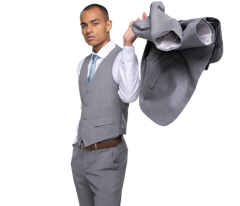How to Choose Between a Peak or Notch Lapel

Just got engaged? Check out our new Groom's Guide!
When choosing a suit, you want to get every little detail right, especially the lapels. This flap of fabric running underneath the collar on either side of your jacket's front is a crucial style choice. It frames the chest and tie and adds to the overall look of the suit or tuxedo.
Here, you'll learn what to choose between the peak vs. notch lapels, two popular options for tuxedos and suits.
Peak vs. Notch Lapel: A Definitive Guide
While considered a critical detail, many people may not notice the differences in lapel styles. There are three main types of lapels, including notch, peak, and shawl, with the first two being the most common options for suits. They vary in design, appearance, length, and formality levels. For example, shawl lapels are almost always on tuxedos for black tie and formal events. In contrast, notch lapels are much more versatile, and you probably already have a business suit with them.
Let's dive deeper into notch and peak lapels' physical characteristics.
Peak Lapels
Peak lapels have sharp upturned edges ending in a single point, also known as the "peak." Traditionally, you'll see them mostly in double-breasted suits, dinner jackets, or tuxedos. These strong points exude a bold and assertive look. Peak lapels were popularized in the 1920s and ebbed and flowed in popularity for tuxedos and suits alike.
Peak lapels are naturally wider than notch and shawl lapels. They can provide a natural broadness to a suit and pair well with wider ties or large bowties to frame the look.
A suit with peak lapels is appropriate in business environments and formal events. Ultimately, they add a bit of sharpness, often paired with more conservative colors like black, dark gray, and navy blue.
Notch Lapels
Notch lapels are more common and appear on single-breasted suits of varying styles. The notch or "step" forms a sideways V-like indentation where the lapel ends below the collar. Typically, these notches will be at a 75- to 90-degree angle.
While mostly classic and somewhat traditional, the notch offers more versatility than the peak lapel and is much more common.
They create a more subdued and refined look, creating a balanced style for semi-formal and more relaxed events. Since they are not a style statement by themselves, you'll need to use other suit details like color pallets and accessories to form your desired look.
Deciding on Peak and Notch Lapels for Different Occasions
Notch and peak lapels ultimately communicate distinct styles and feel. While that can help your overall look, you'll also need to match them to the specific event. Consider asking the host for the dress code to ensure you choose correctly. This will ensure you have the right style and won't feel out of place. However, some general guidelines exist on when to go with one and not the other.
Peak Lapels
Peak lapels are somewhat flamboyant. Since they stand out, they're best for high-status formal events where you want to make a bold statement. Some of these events might include:
- Formal dinners and black tie events – Frequently, you'll use a tuxedo for these events. Peak lapels will ensure you'll look your best with a high degree of sophistication.
- Important business meetings – Peak lapels are good for environments where you need to exude confidence. This makes them a go-to for many high-level influential executives during high-stakes board meetings, conferences, and business dinners.
- Special ceremonies – Peak lapels are the ideal choice for events that require a touch of refined sophistication. This includes formal weddings, galas, award ceremonies, and anniversary dinners. They're a timeless look for special occasions, but can still provide some styling leeway.
Notch Lapels
It's rare to find an event where notch lapels aren't acceptable. They're a safe choice for everyday events and can be used for more formal events. However, they mainly look stylish on occasions such as:
- Semi-formal and relaxed events – Notch lapels blend with semi-formal weddings, relaxed dinners, parties, and dates.
- Job interviews, business casual settings, and everyday wear – With a touch of class and professionalism, notch lapels are the best choice for daily business and job interviews without being too formal.
The notch lapel is the way to go for more common, semi-formal occasions. This is especially true if you don't like drawing too much attention to yourself but still want to look your best.
Pros and Cons of Peak and Notch Lapels
While both peak and notch lapels can look good depending on the occasion, they both have distinct advantages and drawbacks. Keeping their benefits in mind will help guide you to a choice that enhances your personal style in the appropriate setting.
Peak Lapels
The peak lapel has many benefits, and choosing them is right for you if you want your suit to exude these characteristics:
- High formality – You appropriate a formal look and follow the more classical style rules, especially at important events such as traditional weddings or galas.
- Uniqueness – Want to stand out and add some glitz to your dinner jacket or tux? Then choosing peak lapels will ensure an eye-catching appearance.
- Authority – Because of their larger width and broader appearance, peak lapels can often communicate a sense of authority, boldness, and confidence. This makes them a favorite for businessmen during events where impressions matter.
- Broadness – Notch lapels are typically wider, making your shoulders appear broader.
- Eye-catchiness – A non-black dinner jacket with wide black satin notch lapels can create a distinguishing formalwear look even if the shirt isn't exciting.
However, there can be a few drawbacks to peak lapels in certain situations:
- Lack of versatility – Wearing a jacket with peak lapels should be saved for more formal events. If worn to more relaxed occasions, you can risk looking out of place and too overdressed.
- Overbearing – While they might seem bold to many, others might find the peak lapel too overpowering. If you take the look to a more casual event, others might think you're trying too hard.
Notch Lapels
With their highly relaxed appearance, wearing notch lapels can have multiple advantages, including:
- Safety and versatility – When in doubt, go with the notch. It's a look that is safe for most semi-formal and relaxed occasions.
- Classic choice – Notch lapels will help you achieve a timeless and classic look. They have a simple yet formal appeal without being too overbearing.
- Practical – Since they look good in business casual settings, many find notch lapels the best option when wearing a suit daily.
On the other hand, there are a few drawbacks associated with notch lapels:
- A commonplace choice – Those who want to add personal flair to their suits should steer clear of notch lapels. Because of their popularity, they might appear as dull, subdued, and underwhelming.
- Less formality – Notch lapels are less formal overall. Black tie events practically necessitate peak lapels (or a shawl tuxedo) as the style expresses more refined sophistication.
- Lack of assertiveness and style – Notch lapels don't communicate confidence and attention to personal style as peak lapels do. While they can still look distinguished, notch lapels are the best choice for a bold look.
The History of Peak and Notch Lapels
While both are commonly used for suit and tuxedo styles, the peak and notch lapels have different origins. Their rich history has dramatically influenced their uses today.
The History of Peak Lapels
The peak lapel has two important historical points that led to its specific use and style today. These lapels trace back to Victorian-era men's fashion when they first appeared on morning coats and tailcoats. These articles of clothing were seen as essentials for a gentleman's wardrobe and were prominent in high-society functions. Today, peak lapels continue to exude this same air of sophistication.
However, peak lapels weren't just on the jackets of Victorian gentlemen. They also appeared on the double-breasted jackets of naval officers. The sharp upturned peak matched the precise, disciplined, and authoritative aesthetic that many officers preferred. As peak lapels were adopted among many 20th-century military organizations, they became increasingly popular with civilians, too. This solidified their appearance of authoritativeness and bold style.
The History of Notch Lapels
Notch lapels have a history that is less stooped in formality. They first appeared on lounge suits as a cross between the shawl lapel and the peak lapel at the end of the 19th and 20th centuries. During the 1950s and 1960s, they came to prominence and became the lapel of choice for most business casual environments.
Iconic Examples of Peak Lapels and Notch Lapels
Various celebrities and essential figures have used these lapel types for different events. Using them as style role models can help you look your best and create a distinct aesthetic for any occasion.
Iconic Examples of Peak Lapels
Known for his iconic style, James Bond has frequently sported both shawl and peak lapels on his tuxedos and suits. Notice how the peaks align with Bond's distinct authoritative, sophisticated, and confident persona. You'll especially notice suits with peak lapels during black tie events, dinners, and on his most formal occasions.
Renowned fashion designer Tom Ford also loves to use peak lapels to create suits and tuxedos with a classy, eye-catching, and elegant appeal.
Iconic Examples of Notch Lapels
Sure, class and elegance are often associated with the peak lapel. Still, many celebrities have sported the notch lapels for a relaxed yet classical fit. Steve McQueen was known for his timeless style and wore notch lapel suits both off and on screen.
Ryan Gosling, known for his sharp fashion, also frequently sports the notch lapel, matching his laid-back, approachable, yet elegant demeanor.
Because of their ubiquitous appeal, it's hard to find celebrities that don't regularly wear suits with notch lapels. Events that would be otherwise considered formal in Hollywood frequently see examples with famous actors such as George Clooney, Brad Pitt, and Tom Hardy. Because of more lax contemporary fashion trends, some celebrities will also wear tuxedos with notch lapels.
Making the Right Choice: Peak or Notch Lapel
Both peak and notch lapels can enhance your look for a stylish and distinguished appeal. Peak lapels are more formal, bold, and striking, while notch lapels are more classical, relaxed, and subdued. Ultimately, your choice between peak vs. notch lapels will depend on your style preferences and the event's formality.
Black tie events are good opportunities to exude some sophistication with the peak lapel. On the other hand, more relaxed occasions such as semi-formal weddings are suitable for both. Your final choice might also be a matter of practicality. Do you need a suit for everyday office wear, or do you frequently receive invitations for highly formal charity dinners? Ideally, both a peak lapel suit and the notch lapel suit will be valuable additions to your wardrobe that prepare you for any occasion.

Matt Ramirez
Matt Ramirez, a dedicated marketing expert has been with Generation Tux since 2020 after spending 15+ years with global lifestyle brands. With years of experience, he specializes in creating memorable moments for weddings and special occasions. A passionate advocate for classic style and modern convenience, Matt is a trusted voice in men’s fashion.
Link to bio pageFeatured Products
Get started.
Stylish suits and tuxedos delivered straight to your door. See our collection and rent now.

